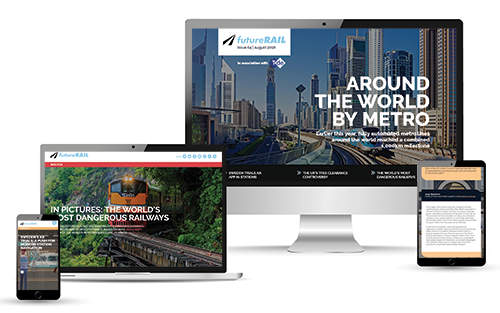
A technology first used in wind turbines is now being used to cut fuel emissions in trains. Created by Edinburgh-based Artemis Intelligent Power, the digitally controlled hydraulic pump is being used by train operator ScotRail to save over 9,000 litres of diesel per carriage per year. We find out more about the project and how digital displacement technologies could be used to cut fuel by up to 30%.
In infrastructure, we map the most significant and innovative of the 63 automated metro lines worldwide, and find out more about Network Rail’s project to cut down trees that drop leaves across 20,000 miles of its track in an attempt to reduce delays and disruption.
Elsewhere, we learn how Sweden’s national train operator SJ is using augmented reality to help passengers navigate its stations, gather the views of industry experts on how rail fares could be improved in the future in a special roundtable feature, and take a look at the world’s most dangerous rail journeys.
Click here to read the latest rail industry news and analysis, and join the conversation on Twitter.
In this issue
Artemis: new tech cuts fuel emissions on trains
A technology first used in wind turbines is now being used to cut fuel emissions from trains. Patrick Kingsland finds out more about the digitally controlled hydraulic pump, which is being used by ScotRail to save over 9,000 litres of diesel per carriage per year.
Read the article here.
Sweden’s AR trials: a push for modern station navigation
One of Sweden’s leading train operators is trialling an augmented reality app to help passengers navigate the country’s busiest station. Eva Grey speaks to Claes Lindholtz, the app’s director of business development and digital transformation, about the company’s willingness to push technological boundaries.
Read the article here.
How well do you really know your competitors?
Access the most comprehensive Company Profiles on the market, powered by GlobalData. Save hours of research. Gain competitive edge.

Thank you!
Your download email will arrive shortly
Not ready to buy yet? Download a free sample
We are confident about the unique quality of our Company Profiles. However, we want you to make the most beneficial decision for your business, so we offer a free sample that you can download by submitting the below form
By GlobalDataAround the world in 1,000km of fully automated metros
In April, the International Association of Public Transport announced that fully automated metro lines around the world had reached a combined 1,000km milestone. Eva Grey explores some of the standout networks around the globe.
Read the article here.
The great tree clearance: does Network Rail need to grow up?
Network Rail’s ruthless new tree clearance plans have drawn the ire of the public and environmentalists alike. Though trackside trees cause well-documented problems for the railways, has the organisation taken things too far? Joe Baker investigates.
Read the article here.
Industry views: how can the UK improve its rail fare system?
UK rail organisations are calling for a complete overhaul of rail fares, arguing that the system must be transparent and offer more flexible fares. Joe Baker asks industry experts: what steps do you believe should be taken to improve the UK’s rail fare system?
Read the article here.
In pictures: the world’s most dangerous railways
From tracks forging a vertigo-inducing path through Colorado’s rocky mountains to Mexico’s crime-plagued railways, Adele Berti rounds up the world’s most dangerous rail journeys.
Read the article here.
Preview – Future Rail September
TFL plans to follow in the footsteps of metros in New York, Toronto and Hong Kong by enabling phone signal underground from 2019 – a move that will provide increased convenience for passengers. We find out how a cellular network can boost the underground economy and provide a safer environment.
In high-speed rail, we take a tour of Spain’s 3,240km Alta Velocidad Española network, which is equipped with state-of-the-art digital signalling, automation and protection systems, as well as predictive maintenance solutions, and find out how Thailand’s new rail infrastructure projects will benefit the country’s economy, after the government approved a $7.2bn high-speed project linking three airports.
Elsewhere, we investigate Brazil’s abandoned rail networks and consider whether some of the unused infrastructure could be revived, explore untapped retail opportunities for rail stations, and find out how dangerous railways can be secured against trespassers.






